Community ProjectsTai Wātea | Waves of Freedom
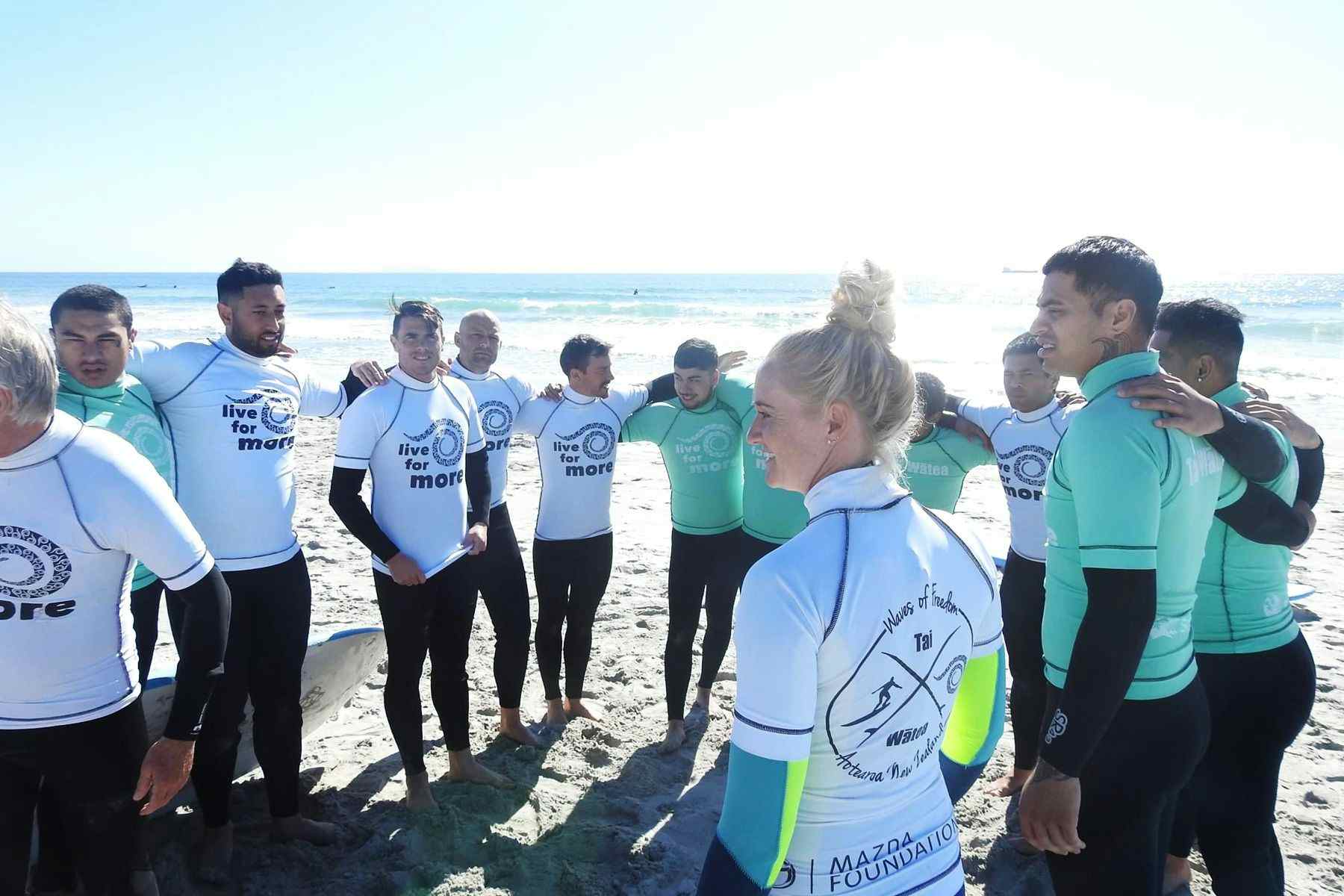
How Effective Is Surf Therapy for Young Men At Risk?
Approximately 90,000 young people in Aotearoa New Zealand are at risk of experiencing adverse life outcomes by the time they reach the age of 32. These include poor economic opportunities, limited education, mental health issues such as substance addiction, and safety and security issues such as correctional sentencing, with an annual cost to the tax-payer of between NZ$180,000 and NZ$410,000 per individual. Among these youth, a 2019 Ministry of Health report found that young Māori men are disproportionately represented in the criminal justice system, have higher rates of alcohol and drug use, and are more likely to contemplate suicide, highlighting the need to find alternative ways to give this cohort the support they need.
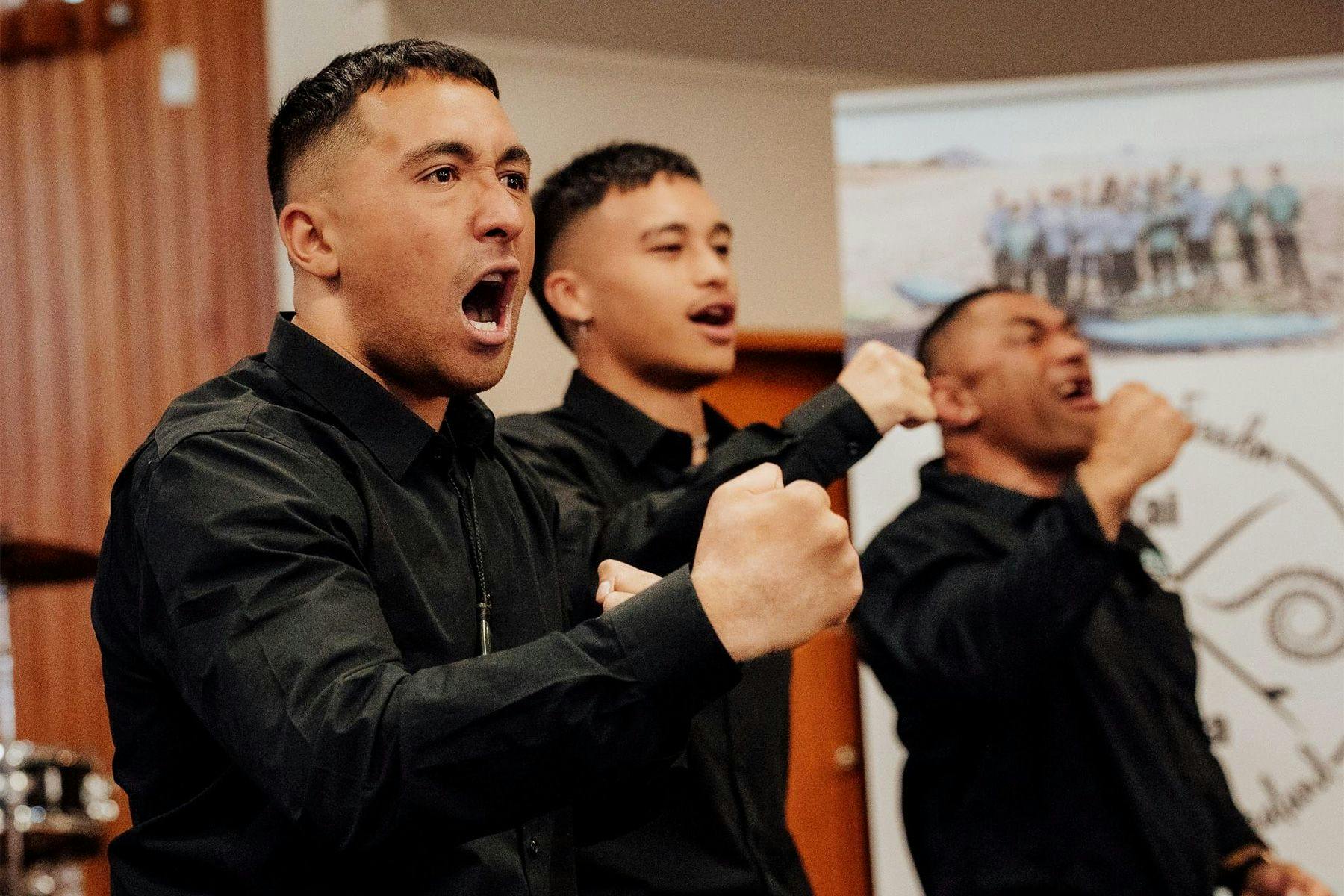
“Although traditional interventions have been somewhat effective, health professionals utilising one or more of these are likely to encounter several obstacles in the process of reaching and retaining high-risk youth for treatment. This includes clients’ chaotic lifestyles, unsupportive friends or family members (especially when the client is part of a gang), low self-efficacy (a major), substance use that makes them too tired or disinterested in showing up for “boring” therapy the next day, distrust in the ‘helping professions’ and authority figures, learnt helplessness, and negative cognitive schemas surrounding “therapy”. Traditional face-to-face assessment and counselling can also be highly uncomfortable for this population. This may be due to anxieties around confidentiality and privacy, unclear or low expectations regarding therapy, feeling that an intervention is irrelevant, or fear of judgement. Community-based adventure therapies (CB-AT) or outdoor-based therapies, like surf therapy, can bypass these issues.”
The above words are part of an interview Surf Simply Magazine conducted with Annericke Leonard, co-author of a paper that came out last year, entitledTai Wātea/Waves of Freedom: an evaluation of a surf therapy programme for improving psychosocial functioning in young men at high-risk of adverse life outcomes. In this study, which was part of her Master’s research project, Annericke and her colleagues, Tatiana Tairi and Neville M. Blampied, sought to be the first to examine the effects of a surf therapy programme on the psychosocial functioning of young men at high risk of adverse life outcomes in Aotearoa New Zealand. Using the Tai Wātea surf therapy program as a case study, they set out to answer the following questions:
1) Does the Tai Wātea surf therapy program reliably improve participants’ psychosocial
functioning?
2) Which aspects of participants’ psychosocial functioning are most improved following attendance in the program?
3) Provided that CB-AT programming does not look like traditional therapy and offers excitement to young people, are program attrition rates lower than that of other community-based programs for justice-involved clients?
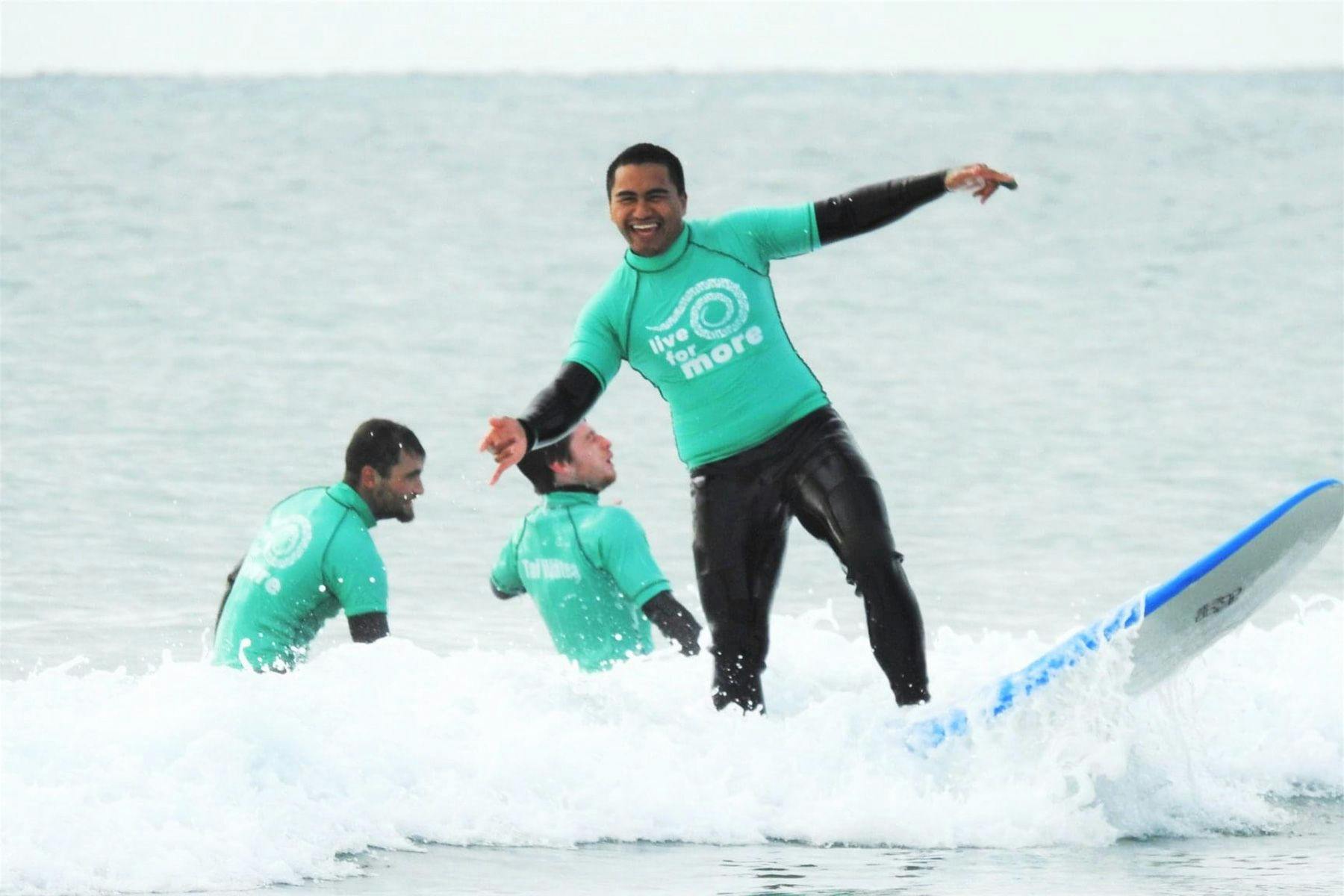
The programme welcomed 6-10 participants for eight weeks. The sessions consisted of four key components: a 90-minute surf session, group discussions based on surfing analogies, cultural work, and a presentation by a guest speaker who shared their experience of overcoming addiction, family dysfunction, gangs, etc. Participants also attended counselling sessions with Krista Davis, the programme founder and a registered drug and alcohol counsellor, as well as weekly one-on-one mentorship sessions with Sean McGuinnity, a local youth worker who helped with practical aspects of leaving the justice system. Finally, a formal graduation ceremony was held for participants and their whānau (family) at the end of their respective programmes.
The authors chose the Youth Outcome Questionnaire Self Report (Y-OQ-SR) questionnaire — a 64-item, self-report outcome measure, widely used to assess psychosocial functioning over the course of therapy — to evaluate the effectiveness of the programme. Twenty-seven participants (22 self-identified as Māori, 4 as New Zealand European and one as a Cook Islander) completed the Y-OQ-SR between one and three times, one week apart. Responses were rated on a 5-point Likert scale, yielding scores on subscales such as Intrapersonal Distress (e.g. anxiety, depression, self-harm), Behavioural Dysfunction (e.g. difficulty with attention, concentration, task completion, etc.), and Somatic Complaints (e.g. headache, dizziness, etc.).
To assess the outcomes of each individual, Annericke and her colleagues looked at the Reliable Change Index and clinical cut-off scores of the Youth Outcome Questionnaire Self-Report. The RCI specifies the minimum score change required between two-time points for the change to be unlikely due to measurement error alone, thus providing evidence for a reliable change occurring due to the intervention. Meanwhile, clinical cut-off scores distinguish clinical levels of functioning (i.e. for inpatient and outpatient samples) from normal levels of functioning (i.e. for community samples).
The data gathered from the Y-OQ-SR was then mapped on Modified Brinley plots (an idiographic technique that enables the identification of clinically significant change and deterioration by incorporating reliable change and clinical cutoffs) at each time point from baseline onwards, in order to investigate change over time. Results indicated that 25 of the 27 participants showed a reliable improvement in psychosocial functioning, with 20 of them also demonstrating clinically significant improvement. Moreover, none of the participants showed deterioration after completing the programme, leading the authors to suggest that these types of interventions could be of great value to its participants, their families, and their wider communities.
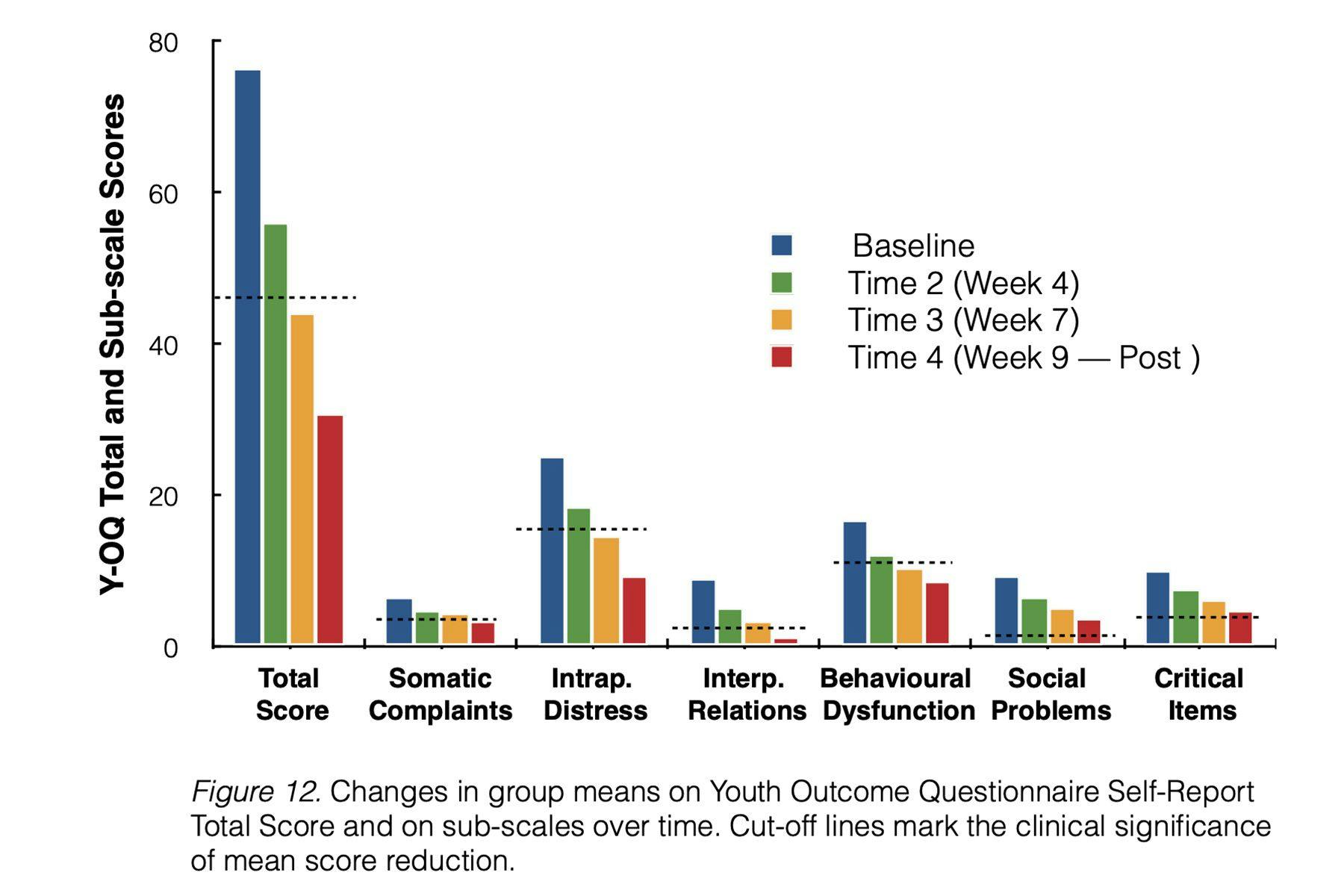
Below are some extracts from the interview with Annericke; the text has been edited for readability.
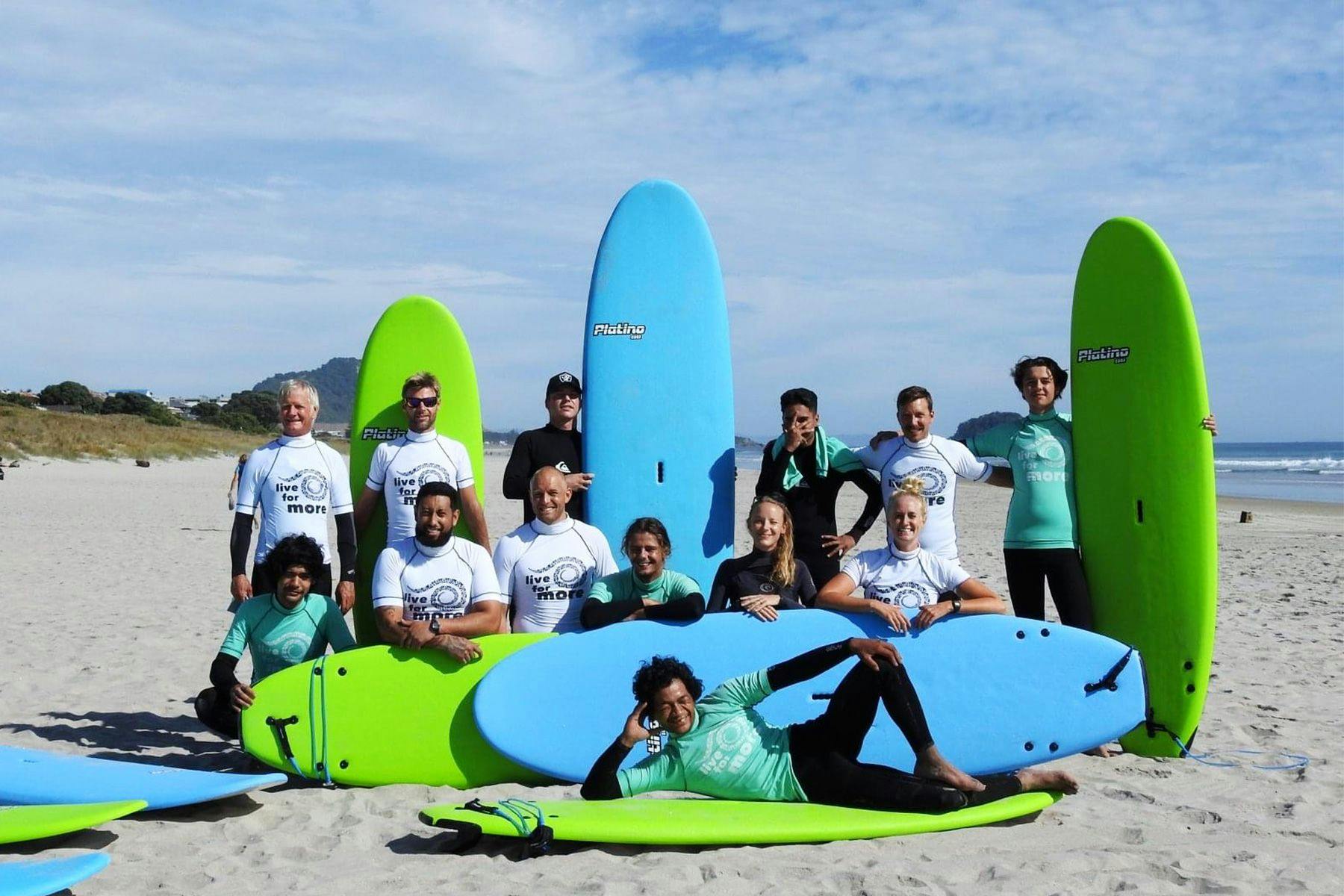
On what makes surf therapy effective
Power Dynamics & Expectations. Establishing a trusting relationship may be easier with outdoor or adventure-based therapies. This is because conducting therapy in nature and within a group-based setting does not typically fit with young people’s negative schemas
around “assessment” or “therapy”, and this can assist in dispelling low expectations and initial defensiveness. Providing therapy on ‘neutral ground’ also promotes mutual vulnerability and accordingly, may shift the power imbalance that many people experience in a traditional therapeutic setting. This assists in achieving a therapeutic alliance with hard-to-reach clients.
Strength-Based. High-risk youth have frequent exchanges with authority figures such as police officers, teachers, and social workers whose occupation is to correct what they perceive to be problematic. The frequently adopted problem-focused approach may hinder the connection between therapist and client. Surf therapy (ST) programmes, however, are inherently strengths-based because challenging activities typically put clients in a position where they must capitalise on their known strengths, and discover new ones, in order to overcome the associated physical and mental obstacles. When participants do overcome challenges through the utilisation of their strengths or talents, or by practising new ones, it renews their sense of mastery and self-efficacy, resulting in more momentum in the now-rewarding pursuit of new ways of thinking and behaving.
Kinaesthetic Metaphor is one of the most unique and advantageous features of surf therapy. A ‘kinaesthetic metaphor’ is a metaphor that is felt, or experienced physically (e.g. persistence in scaling a high cliff despite fear and discomfort being symbolic of the difficult
but rewarding process of becoming sober), rather than brought to one’s mind (e.g. seasonal changes as symbolic of the cyclical seasons of life and living), and can therefore be especially powerful in terms of meaning-making, memory and motivation. Metaphors, especially kinaesthetic metaphors, can be highly valuable to young people who have difficulty with learning, memory, or processing due to a lack of schooling and/or early trauma and neglect. Additionally, high-risk youth commonly move in environments that are adverse, encountering issues such as interpersonal violence, drug abuse, poverty and stress, mental illness, criminality, homelessness and the premature deaths of friends and family.
Contrasting Experience. ST experiences and environments are in stark contrast to such clients’ typical realities or states. Initially, ST programmes can provide a sanctuary for high-risk young people; a safe place away from the always-present stressors in their lives. More than respite though, physical distance from common distractions, normal routines and familiar environments can provide space for a detached, and thus novel, perspective on the people, relationships and elements within their lives that are not beneficial or upbuilding.
‘Contrasting experience’ is an important step in creating an intrinsic, rather than extrinsic, motivation to restructure and re-evaluate the direction of a client’s life.
Developmentally Relevant & Risk-Taking. Young people are predisposed to seeking out opportunities for self-concept development and excitement through risk-taking behaviour. ST programmes are attractive, hold social status and retain the excitement of the unknown and the unexpected. Therefore, it has the unique ability to meet the developmental needs of youth, and naturally increase programme attendance in hard-to-reach youth. Risk-taking falls on a spectrum: one side representing positive risk (e.g. learning to surf; positive because it is legal, socially acceptable or constructive) and the other side representing negative risk (e.g.
stealing a car; negative because it is harmful and not socially desirable or constructive). Surfing can thus be used as an outlet for “positive risk-taking” — which is necessary for life — as it helps us to develop socio-emotional competence, personal responsibility, mastery, autonomy, perseverance and goal setting.
Culturally Relevant. Outdoor-based interventions, such as AT, are more culturally relevant to indigenous youth. Both the spiritual and familial facets of health have conceptual ties to the natural environment. A cornerstone of te ao Māori (the Māori world view) is the awareness of the sacred, interconnected and inherent bond humans have with the natural world — and how frequent contact with specific locations (e.g. forests, mountains, rivers and beaches) can strengthen one’s identity and well-being through maintaining a spiritual connection with tīpuna (ancestors) and whānau. When it comes to therapy, then, integrating places of ancestral significance may be highly valuable and restorative to some indigenous young people. Along with immersion in the natural environment, Jeffery (2017) also argued that the centrality of relationships, the use of metaphor, and group collaboration, are all features of AT that are “compatible with elements of Māori culture” (p. 101).
Flow. Surfing facilitates the psychological state of “flow”. Flow is happening when you feel a sense of “one-ness” with the board and with the oceanic environment, a loss of self-awareness, total immersion and concentration, a distortion of time and a feeling of transcendence. Twenty-five years of research have now established a firm link between frequent flow experiences and an improved sense of well-being and happiness (Csikszentmihalyi, 2020).
Mastery. Surfing also facilitates a sense of Mastery. Experiencing a sense of mastery in developmental tasks, work, or leisure activities, is essential for building resilience, self-efficacy, and a positive self-concept. These attributes, in turn, help us to feel as if we can deal with other challenges in life. It is also what makes many participants say: “If I can learn to surf...what else can I do that I never thought possible?” That is so powerful.
Blue Gym Phenomena. Exercise is an essential part of maintaining and recovering mental health and well-being. It is known that exercising in “green spaces” produce greater effects on mental well-being than exercising in indoor spaces — however, exercise in natural water environments seems to boast even greater benefits (this is called the ‘blue gym phenomena’). Due to surfing involving a combination of substantial physical exertion, a natural water environment, and the exhilarating experience of risk-taking, it has the power to produce a potent neuro-chemical mixture of dopamine, endorphins, and adrenaline.
Spiritual Well-Being. Surfing can help us to foster our spiritual well-being too, in ways other sports can not. For example, anecdotal and academic descriptions of surfing include reports of communion with nature, maintaining a sense of spiritual groundedness, and feelings of
Zen, tranquillity and transcendence (very different from reports on playing rugby haha). More specifically, surfing can provide Māori with a way in which to reconnect with the land and the natural environment more broadly, or more specifically, locations that carry ancestral
significance to them (e.g. Tauranga Moana) — which is immensely important for spiritual health.
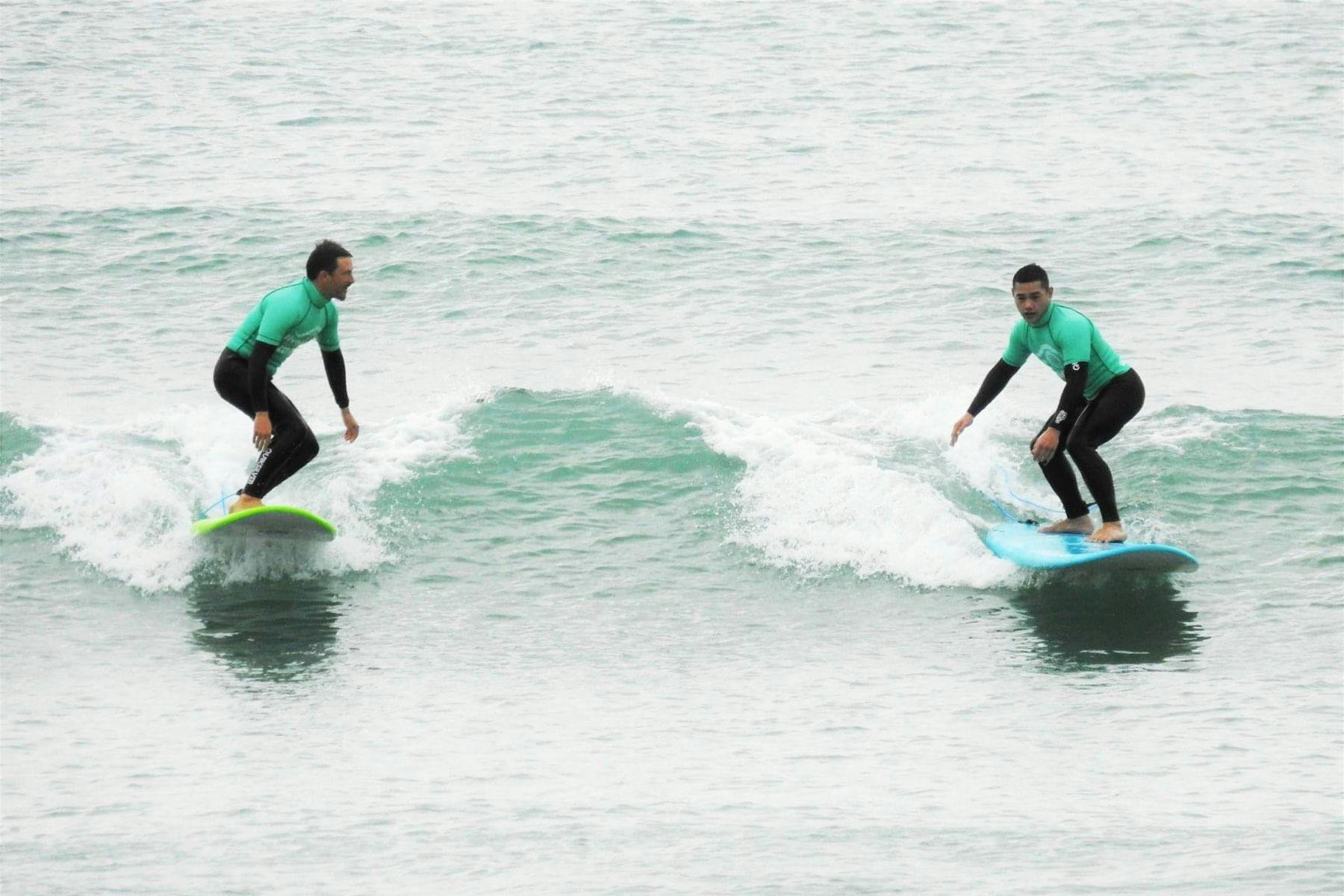
On The Most Relevant And Surprising Findings
I believe the most significant and relevant finding of the research is how effective this tool is in reaching people who really need to be reached for therapeutic intervention (the dropout rate was so low). Another significant point is that it influenced their will to keep living; it actually reduced their suicidal thoughts and actions. Given that they are the most at-risk population, this is massive. This is due to a number of things. Veterans with PTSD (which our boys definitely live with) have revealed that surfing ‘quiets’ PTSD symptoms because it provides relief from ruminating on the past, assists them in becoming present, and promotes hope for the future through a positive mood. Pittsinger and colleagues (2017) found that a mere 30-minute bout of surfing produced statistically significant improvements in their participants’ mood, levels of fatigue and feelings of tranquillity. Surfing also helps the boys to reconnect with their own bodies in a positive way, and to experience a child-like joy and pleasure that they had felt eluded them in their adult lives — something they began to pursue through drug use. The boys always talk about changes in their ‘self-concept’ in learning to and eventually mastering surfing. Reports of increased self-efficacy, self-confidence, self-esteem, self-worth and self-determination are extremely common in surf programme evaluations.
The most surprising finding for me was probably the lack of change in somatic (physical) symptoms. Although I do believe that if the program was longer, this would have changed, not only because of fitness, but because their intrapersonal healing would eventually begin to heal the body. I was also very surprised by the finding that the program could serve as an early intervention for young people who are really struggling with clinical issues that would require medication, such as drug-induced psychosis. I did not see that one coming. But, it makes sense. They reduce their drug use because they are happier, have a place to belong, have fun, find brothers to share life with, and get told how amazing they are all the time. It
heals their hearts… Not only do they use fewer drugs that are harming their brains, but they are also actively beginning to live a happier life. It’s so awesome.
On The Limitations Of The Study
I was only a master's research student, so the time, funding for, and access to a control group of high-risk young people who were either waiting on treatment or undergoing another treatment were impossible. That is why it was very important to get an accurate idea of how they were functioning in the weeks prior to the intervention. Ideally, this would have been a month or two before the intervention began, however, due to their chaotic lifestyles and the fact that many of them do not have a fixed abode, getting stable and consistent baseline data is very difficult with these boys. I do believe though, that the findings of this research are still very relevant and authentic, because of the repeated measures (between 4-6 surveys administered to each participant before and during and after their programme) and the replication of effect (4 different programme intakes with four different sets of young men that show the same pattern).
The two participants that demonstrated no improvement by Time 4, and the few participants that showed signs of reliable deterioration at Time 2 and Time 3 of the intervention demonstrated three study limitations. Firstly, dishonesty at baseline presented a major challenge to the reliability of some of the participants’ outcomes. For example, one of the participants that showed no improvement at Time 4 had in fact received the highest achievement award at graduation (the patu) and is now employed with LFM as a youth navigator (and is absolutely amazing!). The major discrepancy between the quantitative and qualitative data concerning this participant was later revealed to be due to distrust of the researcher and thus, dishonesty at baseline. It was evident with other participants too, that gradual trust in the researcher, and thus, progressive honesty throughout the data collection interviews seemed to translate to ‘no change’, or even ‘deterioration’ at certain time points. This was absolutely expected, and can not really be avoided. However, I decided to do what I could about this and began spending as much time as I could hanging around the office and sitting outside with them and just chatting away with them for a couple of weeks before the surveys began. This seemed to work.
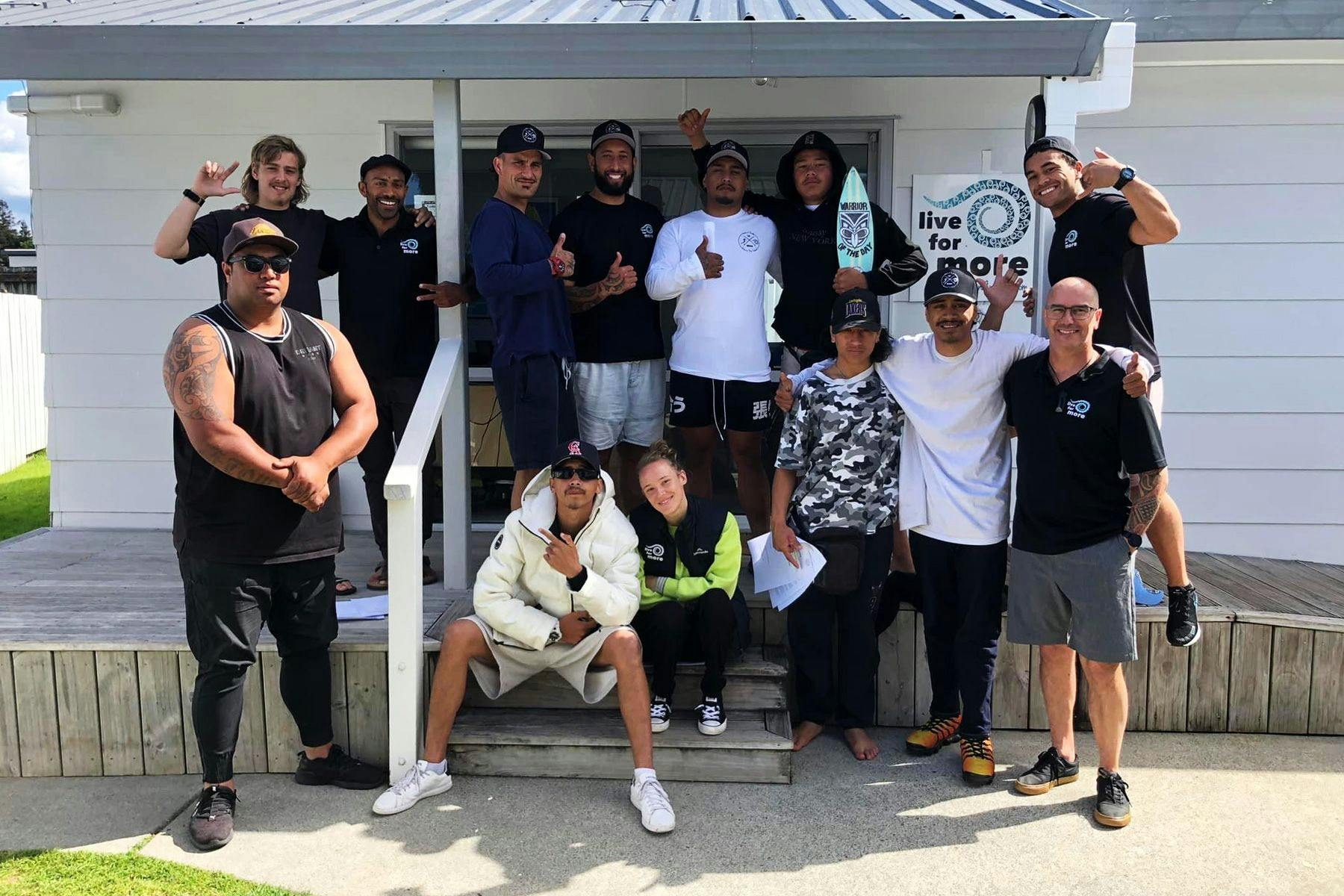
On The Evaluation Tools Used In The Research
The questionnaire that I used was very broad, which is what I really liked about it. I was able to get a gauge on how the programme was reliably and clinically affecting so many different aspects of their functioning, over time. It was an unexpected bonus to be able to see if their suicidal and clinical (psychotic) symptoms were being impacted by the program, by looking at individual items on the questionnaire. That was a major for me because there were not any articles published yet about how surf therapy had quantitatively impacted on hallucinations or delusions or, specifically, suicidal behaviour and thoughts. It was very easy for the boys to answer these questions, too. They could see how it was relevant to their lives and some of them even asked me if they could have the results of their surveys from start to finish. It was like it was concrete evidence of their growth. One of them even said that he was going to frame it. Although quantitative data can be limiting, which I will explain later, it can be so empowering and so insightful. Also, the Live For More charitable trust had a lot of qualitative data and really needed some numbers to back the work that they were doing. I was very happy to do so.
Some interesting outcomes in relation to this research and the tool I used — not mentioned in the article due to word count — was that having only quantitative and self-report data can obscure the true impact of an intervention on certain individuals. For example, the other participant who demonstrated no change at Time 4, was hospitalised in week 6 of his respective programme for mood disturbances as well as episodes of psychosis after the traumatic loss of a family member. Although the data suggested that the programme made no reliable effect on this participant, the participant’s family had disclosed to Live For More staff that the programme had kept him 'stable' at a critical time in his life. In light of this, "no change" was a positive outcome for this individual, as without the intervention, he may have deteriorated even further.
Thirdly, and surprisingly, increased self-awareness and growth posed another major challenge to the reliability of some outcomes. For example, at baseline, some participants indicated that they were happy, enjoying their relationships, or felt in control of their emotions — resulting in low scores on these items at baseline. However, as the programme progressed, participants started to reflect on some of these topics more honestly or to define personal happiness and healthy relationships in alternative ways. Consequently, an increase in self-awareness and personal growth seemed to translate to ‘no change’, or even deterioration at certain time points. These outcomes were proudly included in the Master's Thesis results, as they provide valuable insights to other researchers in regard to the challenges of collecting reliable data with high-risk populations.
Of course, the Y-OQ-SR should ideally be supplemented with the Y-OQ (caregiver or other report). Utilising both measures allow for more robust data and an additional perspective. However, not all participants lived with caregivers, some participants drifted between family and friends, and some resided in tents and homeless shelters. Additionally, the questionnaire assumes that the caregiver themselves are stable and are reasonably aware of the problems facing the person in treatment, and unfortunately, this is not always the case. It was also not considered to be appropriate for LFM staff to fill in Y-OQ questionnaires, as the data would assuredly be subjected to bias. Adding to this, few participants had ‘involved’ parole officers and none had social workers or tutors who could complete the Y- OQ. These issues are why I included qualitative data in the article and included participants’ whole speeches in the Master's thesis.
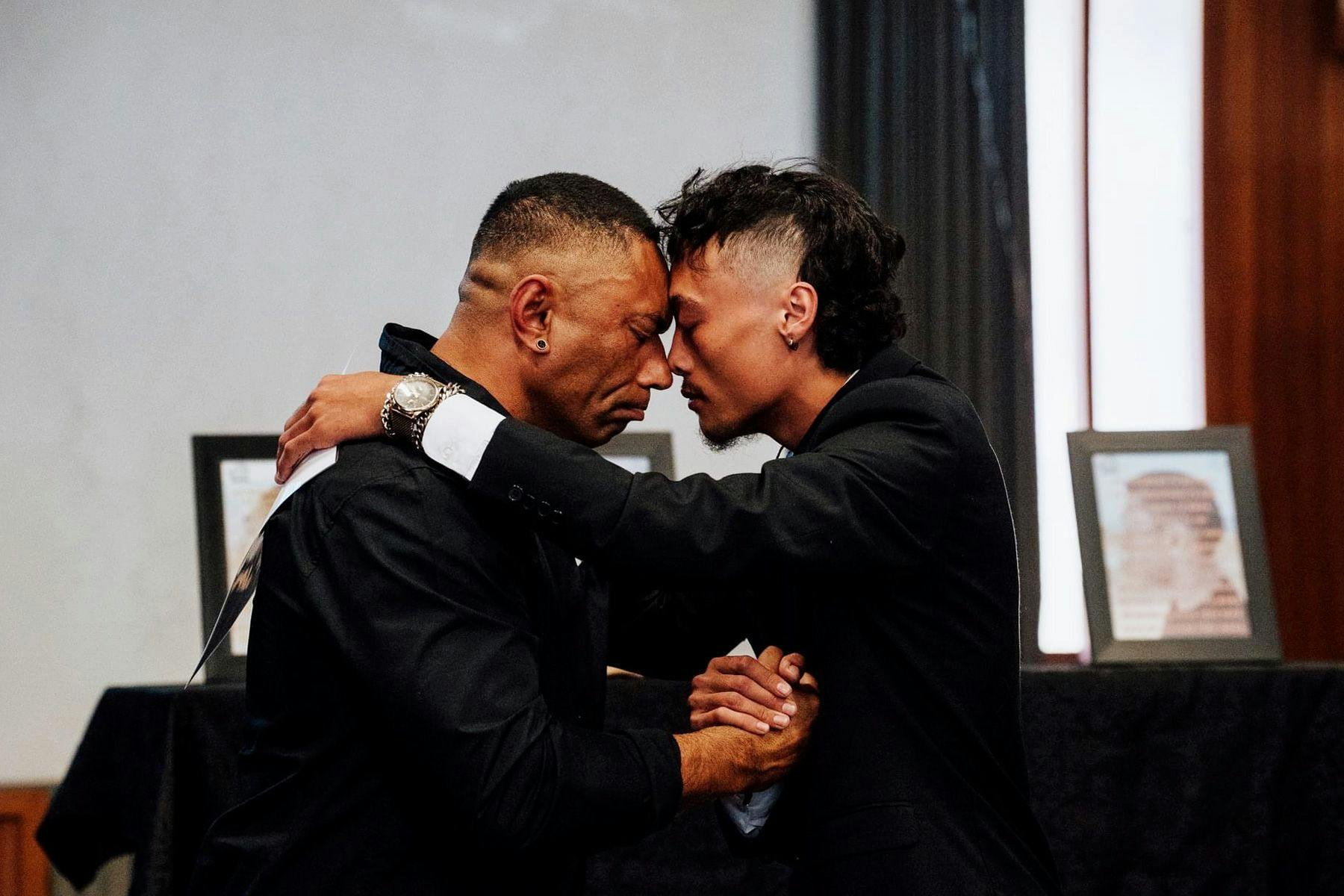
On The Role Of Surf Therapy Developing In The Future
As I have discussed above, surf therapy is incredibly powerful for healing trauma. I have heard of and experienced many people who have more breakthroughs in one session of surf therapy than they do in many traditional talk-therapy sessions, because of how it rewires the brain. Instead of healing alone, you are healing within a safe and encouraging relationship and you redefine your self-concept through this. Instead of healing being hard and heavy, surfing makes healing joyous and fun. You learn to see your power, you understand that you have more potential than you thought possible. Your brain gets a chance to rest, in flow. You feel one with nature, and you belong. These are all very powerful healing modalities that talking about trauma, alone, cannot achieve effectively. Sometimes talking about therapy is good, and a necessary part of healing. But, one must then begin to build a new, healthier, view of the world and yourself, and surf therapy in groups helps you to do this. It is a “corrective emotional experience” for many people.
Therefore, I believe that surf therapy will develop in the future to involve more types of people, expanding its use for more niche groups, and in more countries. One friend I know is starting a surf therapy container for people who have gone through religious trauma and have lost their trust in and relationship with ‘God’, for example. They will make their beach-circle sessions about connecting deeper with themselves, nature, and the universe in general and building that into a reconstructed and healthier view of faith, spirituality, and universal love. This is a great example of how surfing acts as a unique healing modality in a way that other sports cannot, and other talk therapies cannot.
On The Main Factors That Should Be Taken Into Account When Developing Similar Programmes Either In Aotearoa NZ Or Elsewhere
Surfing is an inherently Polynesian sport. There should be more teaching about its roots, and more research on how surfing and surf therapy can be powerful for Polynesian youth. It is so empowering for Māori youth to know that surfing is not a white male sport. It was developed by indigenous men and women, and more than a sport, surfing was a practice embedded within the political, cultural, social and spiritual fabric of Hawai’ian society. On this, here’s segment from my thesis: "Every part of surfing was governed by a ritualised set of practices called kāpu (Laderman, 2014). For example, before trees were cut down to construct a board, a kahuna (priest) placed a ho‘okupu (fish offering) by the chosen tree as thanksgiving (Finney, 1959). Once the board was shaped, a dedication ceremony was held at the local heiau (temple), again signifying a sensitivity to and gratitude for the gifts of earth and ocean (Houston & Finney, 1996; Kampion, 2003; Taylor, 2007), and of course, “[insuring] its success in riding the waves” (Finney, 1959, p. 338). Traditional Hawai’ian kū mai (arise) chants were also frequently chorussed before the ocean, as they were believed to conjure and command ocean swells (Walker, 2011).”
There needs to be more psychoeducation with participants of these programmes regarding the brain and the nervous system and how trauma affects the way our brain receives and processes information. This helps them to understand themselves, and how surfing actively rewires their brains. I find this to be important because it gives the
participants more control, through knowledge. Instead of delivering a “mystery, magical” service, they know what is happening, and they can feel more in control of their stories.
Finally, there needs to be multi-modal intervention approaches in one programme to make it as effective as possible. For example, with Tai Wātea, we have cultural work (learning pepeha and haka), group therapy, 1-1 therapy, surf therapy, and practical mentorship and coaching on how to get out of the justice system and into mainstream society. All of this is what I believe made the programme as successful as it is.
*****
The author and Surf Simply would like to thank Annericke Leonard for her time and insights, and Tai Wātea | Waves of Freedom for sharing the images. Follow them on Instagram to keep up to date with news about the programmes.
Reference:Annericke Leonard, Tatiana Tairi & Neville M. Blampied (2022): Tai Wātea/Waves of freedom: an evaluation of a surf therapy programme for improving psychosocial functioning in young men at high risk of adverse life outcomes, Journal of Adventure Education and Outdoor Learning, DOI: 10.1080/14729679.2022.2153370